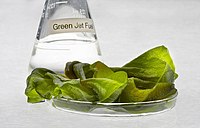
Photo from wikipedia
Abstract Biomass gasification effluent primarily contains polycyclic aromatic hydrocarbons (PAHs) generated during wet scrubbing of synthetic gas. These PAHs are toxic, mutagenic, carcinogenic and teratogenic, which, therefore, need to be… Click to show full abstract
Abstract Biomass gasification effluent primarily contains polycyclic aromatic hydrocarbons (PAHs) generated during wet scrubbing of synthetic gas. These PAHs are toxic, mutagenic, carcinogenic and teratogenic, which, therefore, need to be removed prior to their release into the environment. This study was performed to determine the valorization of PAHs from biomass gasification effluent as a substrate for Rhodococcus opacus and its potential for biodiesel production. Using synthetic media containing 2-, 3- or 4- ring PAH compounds, at an initial concentration in the range 50–500 mg L−1, along with 5% (v/v) inoculum, the bacterium degraded 75.9% naphthalene, 79.1% phenanthrene and 72.1% fluoranthene, with a corresponding lipid accumulation of 68.1%, 72.4% and 63% (w/w) of cell dry weight (CDW) respectively, within 7 days. The maximum specific growth rate (μmax) of the organism was found to be 1.267 × 10−4 min−1, 2.47 × 10−4 min−1 and 2.317 × 10−4 min−1 using naphthalene, phenanthrene and fluoranthene, respectively. Further, an increase in the inoculum size to 10% (v/v) had a positive effect on both PAHs biodegradation and lipid accumulation by the bacterium. 1H and 13C nuclear magnetic resonance (NMR) spectroscopy affirmed that the fatty acids accumulated by the bacterium primarily contained saturated fatty acids. Gas chromatography (GC) analysis of the transesterified lipids to biodiesel further revealed the presence of methyl palmitate and methyl stearate as the major fatty acid methyl esters (FAMEs). The estimated properties of the transesterified product indicated its best potential for biodiesel application.
Journal Title: Journal of water process engineering
Year Published: 2017
Link to full text (if available)
Share on Social Media: Sign Up to like & get
recommendations!